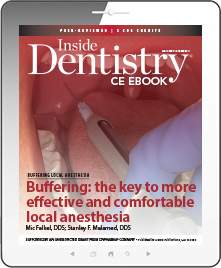Buffering: the key to more effective and comfortable local anesthesia
Mic Falkel, DDS; Stanley F. Malamed, DDS
Monday, June 1, 2020 - Expires June 30, 2023
Commercial Supporter:

KEY TAKEAWAYS:
-
Discuss the time course of local anesthesia as it relates to procedures in dentistry
-
Describe the variables that must be controlled to reliably buffer a local anesthetic.
-
List methods of testing for pulpal anesthesia.
-
Review the options for buffering local anesthetics in dental practice.
Buffering of local anesthetics offers significant advantages for the dentist and patient. Dentists must understand the time course of anesthesia, the factors that contribute to inconsistent anesthetic performance, and how the body must overcome the acidity of local anesthetic injections before the anesthetic can take effect.
Buffering local anesthetics to a neutral pH range addresses inconsistencies in anesthetic performance such as speed of onset, depth of anesthesia, comfort of injection, predictability, and patient perception.
Download to earn 2 FREE CEU now!





